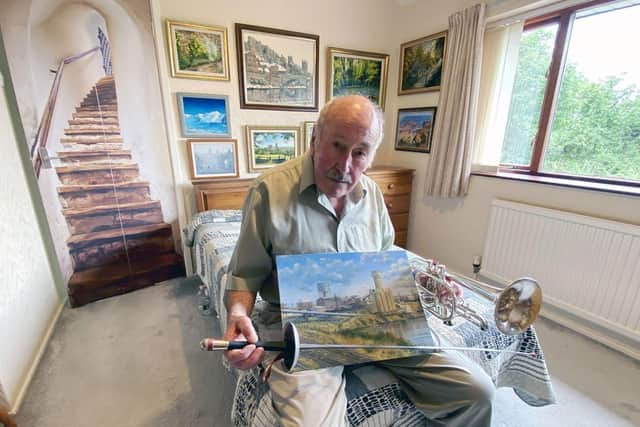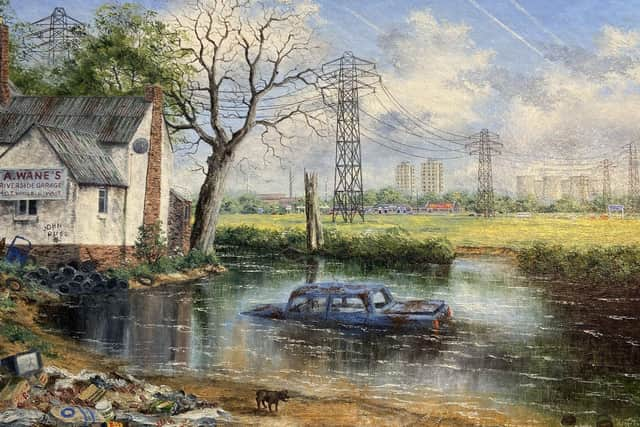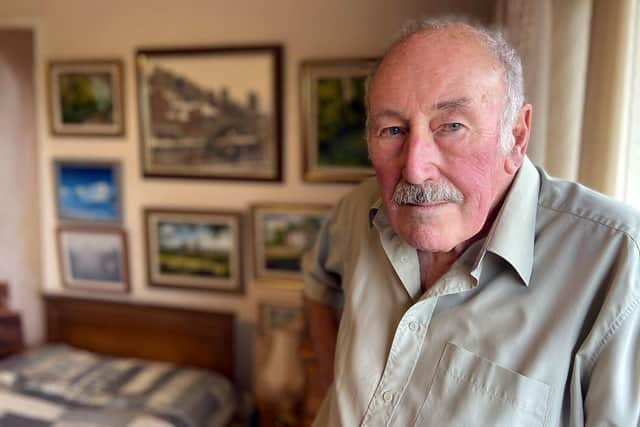An ode to Ryhope swordsman, artist and jazz musician Clive Madgin, one of Sunderland's most interesting sons
and live on Freeview channel 276
Meet Clive Madgin, one of Ryhope’s most interesting sons. Now in his 80s, widowed with three grown-up children, he seems an unassuming sort of gentleman. But dig a little deeper…
He said: “I literally turned my hobbies into a job. I did set it up as as a business with an accountant. My wife was the secretary.
Advertisement
Hide AdAdvertisement
Hide AdClive was born in Corrie Street in Ryhope, now long demolished. He spent much time at his grandparents’ home in Nicholson Street, followed by a life much-lived. Read on.


Clive the fencer
Clive’s life took many an unexpected turn, starting when he became an expert swordsman; not a commonplace skill in Ryhope.
He said: “Initially I was a teacher. Then while I was at college I learned to fence. I took to it like a duck to water and became captain of the fencing team. After that any fencing course that came up I would go on, to improve my qualifications.”
Eventually he was accepted by the British Academy of Fencing, which teaches the coaching of fencing. He only recently gave up the sport after 64 years for health reasons and misses it very much.


Advertisement
Hide AdAdvertisement
Hide AdHe eventually made a good living from fencing when it became a popular after-school activity. As a member of the Harlequins Fencing Club he gave lessons at Thornhill School.
Many people around the North East remember Clive putting them “on guard” during their school days. He did that for over 20 years.
Clive the Artist
Clive also became a professional artist. He has no formal art qualifications, but from being a small boy could draw and paint and has done so all his life. Sheer artistic talent opened another career path.


He explained: “I gained permission to exhibit paintings in a courtyard next to Framwellgate Bridge in Durham and sold paintings to lots of tourists. At the last count I’ve got paintings in 36 countries.”
Advertisement
Hide AdAdvertisement
Hide AdOne painting is in Chile, although there was plenty of local interest too. He sold pictures from the forecourt from the mid-1960s to the mid-1990s.
He added: “I don’t do portraits or people. But, if I say so myself, I’m pretty good at painting old buildings, derelict sites, sea pictures, river pictures. I also liked painting pictures of the old coal mines as they were closing down. They were very popular.”
Clive’s last coal mine painting was of Monkwearmouth Colliery, which closed in 1993 with its site now occupied by the Stadium of Light.


The painting was created using old photographs of the colliery. Sunderland AFC bought it from him, but he painted another version which he has kept.
Advertisement
Hide AdAdvertisement
Hide AdThe number of collieries he painted is in the hundreds. The prestigious Mining Art Gallery in Bishop Auckland is currently displaying three of them. One of his more unusual works is a stunning 21st century update of John Constable’s 1821 painting The Hay Wain.
Clive said: “Instead of the wagon in the river I put a wrecked car. The big tree opposite the house became a dead tree with bare branches and I painted a pile of rubber tyres beside the house.”
Clive still owns his Hay Wain and won’t sell it.
Clive the trumpeter with jazz great Humphrey Lyttleton
Clive began to play the trumpet at about the same time he learned to fence.
He said: “I bought a beat-up old trumpet for £5. Everybody was keen on jazz then. I learned by playing jazz records and joining in: King Oliver, Johnny Dodds, Kid Ory. All the really old stuff from the 1920s.
Advertisement
Hide AdAdvertisement
Hide Ad“It faded out when the big bands took over, but there was a revival in the 1940s and it spread to England with people like Chris Barber, Ken Colyer – and Humphrey Lyttleton.”
Lyttleton was born into nobility in 1921. He became a cartoonist and radio personality, known for his hilarious chairing of I’m Sorry I Haven’t a Clue until his death in 2008.
But he is probably best remembered as a jazz trumpeter and leader of the Humphrey Lyttleton Band, working with artists as diverse as Acker Bilk, Elkie Brooks and Radiohead. He also worked with Clive Madgin and his band, Savoy Jazz.
Clive recalls: “We played for many years at the Redhills Hotel in Durham. He played with us there. He would come and spend weekends with us and we would play maybe Darlington Arts Centre on a Saturday night and the Redhills on the Sunday.
Advertisement
Hide AdAdvertisement
Hide Ad“He was a very nice man. We thought he might be a bit aloof, but he was just on of the fellas. He was very friendly and normal and always making little jokes.”
Clive also played many times in Sunderland including a number of shows at the museum during the 1970s.
The band didn’t make much money initially, but by the 1980s were playing many weddings and even funerals. Savoy Jazz toured the North East and music became quite lucrative too, playing regularly at Wearside venues including the Ropery in Deptford.
They also travelled to Albert in France and Durham’s twin town in Germany, Tübingen, building up interest until they were playing before crowds of hundreds.
Apart from all that…
Advertisement
Hide AdAdvertisement
Hide AdClive was married to Irene from 1970 until she passed away in 2019. They had three children: Kenneth, Julie and Edward.
National Service called with a posting in Schleswig/Jagel in northern Germany as an RAF radar operator and “good skiver”. He made sure he was sent all over Germany on courses, which he regarded as free trips out. However he did learn to speak German.
He concludes: “There’s a song called I was Born Under a Wandrin’ Star. I think I was born under a lucky star.”
We wonder if he has ever been bored.
